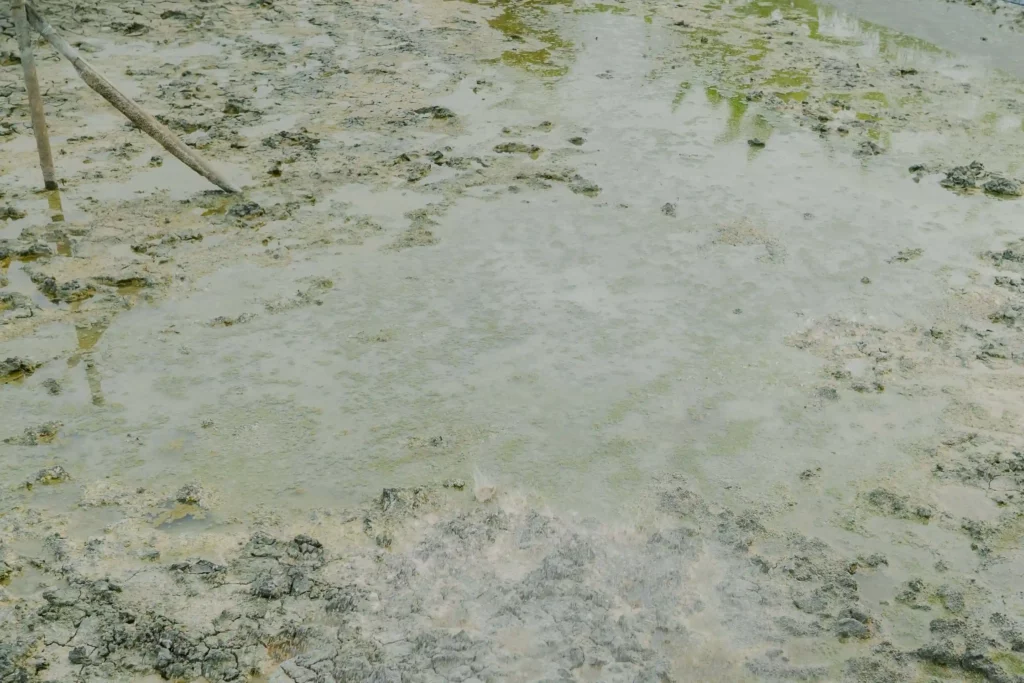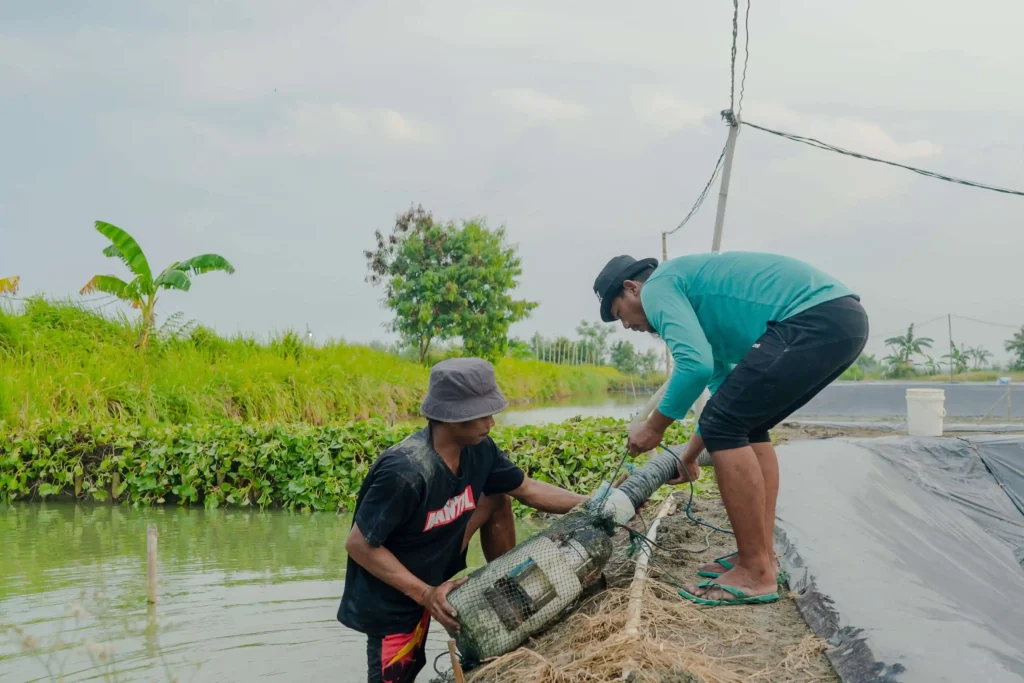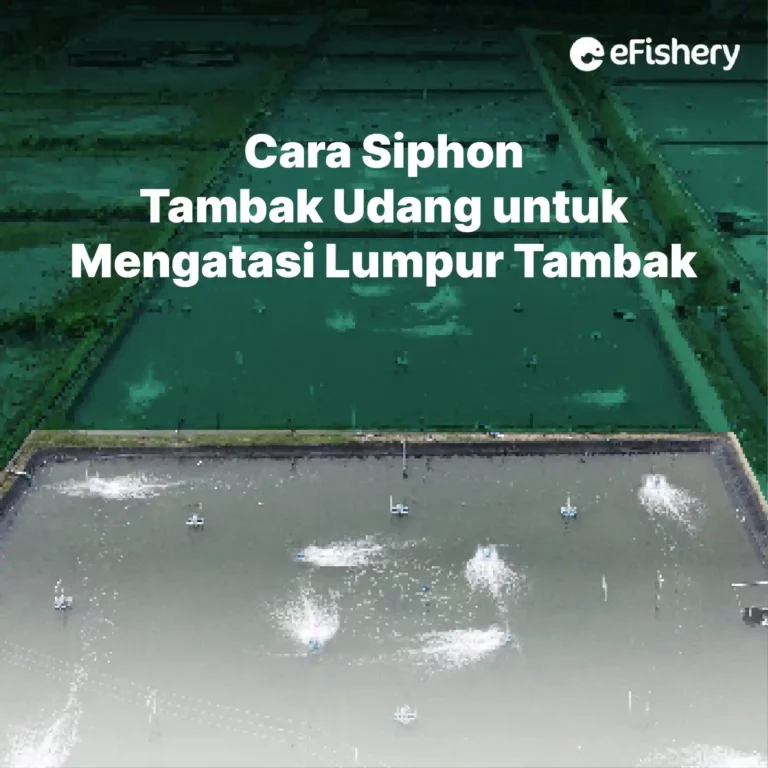Artikel Ini Telah Direview Oleh:

Eko Afriantoro
Praktisi Budidaya Udang
The siphon method for shrimp ponds is quite easy and you can do it by following the tutorial in the following article. However, it should be noted beforehand that the siphon method is important for you to do to clean up the sludge that settles at the bottom of the shrimp pond using a special drain.
Sludge is created from leftover feed, plankton carcasses, and the shrimp's own metabolism so that there is a lot of organic matter that settles and affects water quality, especially dissolved oxygen levels. See further explanation about the importance of the siphon method and the correct method of siphoning shrimp ponds.
Siphon for Shrimp Ponds
Shrimp pond siphon is a way to deal with shrimp pond sludge using a siphon hose connected to a drain outside the pond by utilizing the force of gravity and water pressure.
Leftover feed and organic waste that settles and turns into sludge will be stored in a disposal tank or WWTP first. Then, the siphon hose will suck up the sludge from the bottom of the pond and out through the drain.
Apart from cleaning the siphon that settles at the bottom of the pond, the siphon method can also detect molting and death in shrimp, prevent shrimp from contracting disease, and maintain water quality.
The Importance of Siphons for Shrimp Ponds
It is important to clean shrimp ponds using the siphon method, especially if the shrimp pond has silt deposits at the bottom. The main benefit of a siphon is to clean and maintain the quality of shrimp water ponds from silt.
Uncontrolled sludge build-up will create a high ammonia content in the water as well as hydrogen sulfide. These two compounds are very dangerous for shrimp and can threaten their survival with the potential for mass death.
The presence of sludge waste in shrimp ponds can cause a foul odor and become a storage place for various types of viruses and bacteria that can cause disease in shrimp, one of which is vibrio bacteria. Vibrio bacteria are a type of facultative anaerobic bacteria that can cause vibriosis.
In addition, the benefits of siphons are helping the growth of aquaculture animals in ponds, helping the shrimp's sense of sight to see clearly, the process of respiration, avoiding premature death, and molting in shrimp.
How to Siphon a Shrimp Pond

The correct and coherent way to siphon shrimp ponds is to start with preparation central drain, installed a siphon hose, and sucked up some of the sludge. The suction technique used, the correct way to dispose of the sludge, and other alternative ways to control sludge are also things that must be considered.
1. Prepare CentralDrain
Central drain or shrimp toilets is a special container or media that is deliberately made to store sludge which will be sucked up through the sewer. Ideally shrimp toilets has an area of 5-7% of the total area of the pool with a depth of 0.5-1 meter and is designed to be sloping.
2. Installing the Siphon Hose
The next step is to install a siphon or drain hose to the outside of the pond. The hose will be connected with central drain sludge storage. Later, the mud will be sucked in and flowed out towards central drain through the siphon hose.
It should be underlined that the drain cover must be open in order to drain the sludge to be disposed of. In addition, you need to prepare replacement water because usually the sludge that comes out will carry water from the pond.
3. Sludge Sucking Technique
There are 2 techniques that you can apply to suck up mud from the bottom of the pond, namely the technique using a special pump or machine, and the technique without a pump. Techniques that use special pumps or machines are claimed to be more effective in cleaning mud, because the suction process will occur in a short duration. However, you need to prepare quite a large amount of money to buy and operate the pump.
While the technique without a pump in question is a sludge suction technique that relies on gravity. This technique is considered easier and cheaper. The drawback is that the gravity technique can only be performed when the pond bottom surface elevation is the same height as the drain elevation designed to surround the pond to the bottom. central drain.
4. Treating Sludge Waste Properly
The sludge contains chemical compounds that are quite dangerous so that when you suck it up, you can't just throw it away. This can pollute the surrounding environment.
Find out in advance how to treat the sludge waste before it is finally discharged into open waters. For example by precipitating sludge in the past few days using a special method to decompose the appropriate and proper concentration of waste.
5. Alternative Ways to Reduce Sludge in Shrimp Ponds
To maximize the siphon method, you can combine it with other methods to maintain pond quality, including:
- Add dissolved oxygen using a machine nanobubbles so that it can increase biological lysis reactions, stimulate autolysis in bacteria, and reduce the amount of sludge production.
- Soil turning method, this method is carried out by plowing the pond bottom soil with the aim of releasing toxic gases and loosening the soil and killing pests, bacteria and disease viruses.
- The liming method uses zeolite and dolomite at a dose of 1 ton/ha. The purpose of the method is to neutralize soil acidity and kill harmful viruses and bacteria.
- Provide fertilizer to restore soil fertility and prevent bacteria and viruses that are harmful to shrimp.
Things to Look For When Siphoning Ponds

Even though the mud contains harmful ingredients for pond biota, the presence of mud is actually still needed by the pond as a bioreactor that plays a direct role in the nutrient cycle of shrimp ponds.
When you suck up the mud, what will happen is excessive fluctuation of nitrogen compounds such as ammonia, nitrate and nitrite. Therefore, the purpose of this siphon method is actually to control the amount of silt in the pond.
If too much silt is sucked up, the impact is the creation of nests of pathogenic bacteria such as vibrio bacteria. On the other hand, if the mud is still there or is sucked up in small quantities it will also mix with the water, and the harmful content in it will mix with the pond water.
Opportunity for Free Shrimp Cultivation Consultation at eFarm
Need Help Regarding Shrimp Cultivation Business?
Fill in your personal data in the following form. Our team will immediately contact you via the number cellphone attached. Make sure the data entered is correct.
The biggest problem with shrimp farming is that shrimp are easily exposed to bacteria and certain disease outbreaks, so their maintenance must be extra careful and more thorough. Now, Mr / Mrs Farmers have the opportunity to get free assistance in managing aquaculture management, especially shrimp ponds.
Consult your shrimp farming problems with the experts at eFarm through special features eFarm Cultivation Consulting. There are many aquaculture and shrimp farming experts who are ready to discuss with you in person on line. Starting from issues of feed, water and waste treatment, tips on preventing disease, to other aquaculture management recommendations.
Let's download it immediately eFarm right now!

Eko Afriantoro - Praktisi Budidaya Udang
Eko berpengalaman sebagai praktisi budidaya udang sejak tahun 2013 yang kini menjadi Farm Lead Research & Development (R&D) Shrimp eFishery.
Questions Regarding Shrimp Pond Siphons
The sludge that settles at the bottom of shrimp ponds needs to be controlled and disposed of regularly because the sludge contains many viruses and bacteria, one of which is vibrio bacteria. Vibrio bacteria are a type of bacteria facultative anaerobes which can cause vibriosis.
Cleaning shrimp ponds using the siphon method is important to do, especially if shrimp ponds have silt deposits at the bottom. The sludge is created from leftover shrimp feed waste, plankton bodies and shrimp metabolism results that settle. If not controlled, the high ammonia and hydrogen sulfide content will be harmful to shrimp.
- https://app.jala.tech/kabar_udang/siphon-sedot-lumpur-sarang-bahaya
- https://delosaqua.com/id/peralatan-tambak-udang-vaname/
- https://kincirair.id/2021/01/12/mengenal-siphon-pada-tambak-udang/
- http://minalokajaya.blogspot.com/2015/11/pembuangan-system-bisonpilasi.html
- https://nanobubble.id/blog/siphon-kolam-apakah-penting
- https://tambakudang.com/siphon-metode-mengeluarkan-lumpur-dari-tambak-udang/#:~:text=Cara%20kerja%20dari%20siphon%20jenis,mengalirkan%20lumpur%20yang%20hendak%20dibuang.
